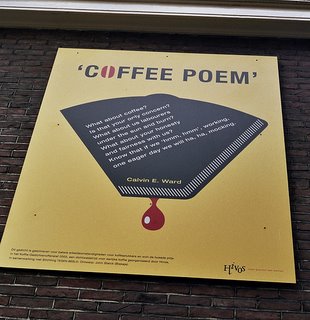 photography provided through flikr
photography provided through flikr
But beverage is still no substitute for fruits and vegetables
The Associated Press
WASHINGTON - When the Ink Spots sang “I love the java jive and it loves me” in 1940, they could not have known how right they were.
Coffee not only helps clear the mind and perk up the energy, it also provides more healthful antioxidants than any other food or beverage in the American diet, according to a study released Sunday.
Of course, too much coffee can make people jittery and even raise cholesterol levels, so food experts stress moderation.
The findings by Joe A. Vinson, a chemistry professor at the University of Scranton, in Pennsylvania, give a healthy boost to the warming beverage.
“The point is, people are getting the most antioxidants from beverages, as opposed to what you might think,” Vinson said in a telephone interview.
Antioxidants, which are thought to help battle cancer and provide other health benefits, are abundant in grains, tomatoes and many other fruits and vegetables.
Vinson said he was researching tea and cocoa and other foods and decided to study coffee, too.
His team analyzed the antioxidant content of more than 100 different food items, including vegetables, fruits, nuts, spices, oils and common beverages. They then used Agriculture Department data on typical food consumption patterns to calculate how much antioxidant each food contributes to a person’s diet.
They concluded that the average adult consumes 1,299 milligrams of antioxidants daily from coffee. The closest competitor was tea at 294 milligrams. Rounding out the top five sources were bananas, 76 milligrams; dry beans, 72 milligrams; and corn, 48 milligrams. According to the Agriculture Department, the typical adult American drinks 1.64 cups of coffee daily.
That does not mean coffee is a substitute for fruit and vegetables.
“Unfortunately, consumers are still not eating enough fruits and vegetables, which are better for you from an overall nutritional point of view due to their higher content of vitamins, minerals and fiber,” Vinson said.
Dates, cranberries, red grapes
Dates, cranberries and red grapes are among the leading fruit sources of antioxidants, he said.
The antioxidants in coffee are known as polyphenols. Sometimes they are bound to a sugar molecule, which covers up the antioxidant group, Vinson said.
The first step in measuring them was to break that sugar link. He noted that chemicals in the stomach do the same thing, freeing the polyphenols.
“We think that antioxidants can be good for you in a number of ways,” including affecting enzymes and genes, though more research is needed, Vinson said.
“If I say more coffee is better, then I would have to tell you to spread it out to keep the levels of antioxidants up,” Vinson said. “We always talk about moderation in anything.”
His findings were released in conjunction with the annual convention of the American Chemical Society in Washington.
In February, a team of Japanese researchers reported in the Journal of the National Cancer Institute that people who drank coffee daily, or nearly every day, had half the liver cancer risk of those who never drank it. The protective effect occurred in people who drank one to two cups a day and increased at three to four cups.
Diabetes risk
Last year, researchers at the Harvard School of Public Health found that drinking coffee cut the risk of developing the most common form of diabetes.
Men who drank more than six 8-ounce cups of caffeinated coffee per day lowered their risk of type 2 diabetes by about half, and women reduced their risk by nearly 30 percent, compared with people who did not drink coffee, according to the study in Annals of Internal Medicine.
Bonnie Liebman, nutrition director of the Center for Science in the Public Interest, said she was not surprised by Vinson’s finding, because tea has been known to contain antioxidants.
But Liebman, who was not part of Vinson’s research team, cautioned that while many people have faith that antioxidants will reduce the risk of cancer, heart disease and more, the evidence has not always panned out. Most experts are looking beyond antioxidants to the combination of vitamins, minerals other nutrition in specific foods, she said.
This article previously appeared on msnbc.com - http://www.msnbc.msn.com/id/9105892/













